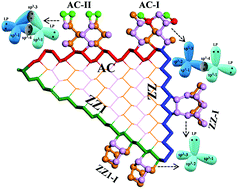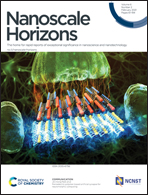Self-passivation leads to semiconducting edges of black phosphorene†
Abstract
The edges of black phosphorene (BP) have been extensively explored. The previous experimental observations that all the BP edges are semiconducting implies that the as-cut edges of BP tend to be reconstructed. Here we present a global structural search of three typical BP edges, namely armchair, zigzag and zigzag-1 edges. It is found that all the three pristine edges are metastable, and all of them can be quickly self-passivated by (i) forming P![[double bond, length as m-dash]](https://www.rsc.org/images/entities/char_e001.gif) P double bonds (one σ and one π bond), (ii) reconstructing new polygonal rings will all P atoms bonded with three sp3 bonds or (iii) forming a special P(2)–P(4) configuration with a two-coordinated P atom accommodating two lone pair electrons and one four-coordinated P atom without lone pair electrons. Highly different from the pristine edges, all these highly stable reconstructed edges are semiconducting. This study showed that the reconstruction of the edges of a 2D material, just like the surfaces of a 3D crystal, must be considered for both fundamental studies and practical applications. Besides BP, this study also sheds light on the structures and properties of the edges of many other 2D materials.
P double bonds (one σ and one π bond), (ii) reconstructing new polygonal rings will all P atoms bonded with three sp3 bonds or (iii) forming a special P(2)–P(4) configuration with a two-coordinated P atom accommodating two lone pair electrons and one four-coordinated P atom without lone pair electrons. Highly different from the pristine edges, all these highly stable reconstructed edges are semiconducting. This study showed that the reconstruction of the edges of a 2D material, just like the surfaces of a 3D crystal, must be considered for both fundamental studies and practical applications. Besides BP, this study also sheds light on the structures and properties of the edges of many other 2D materials.

- This article is part of the themed collection: Nanoscale Horizons 2022 Lunar New Year Collection


 Please wait while we load your content...
Please wait while we load your content...